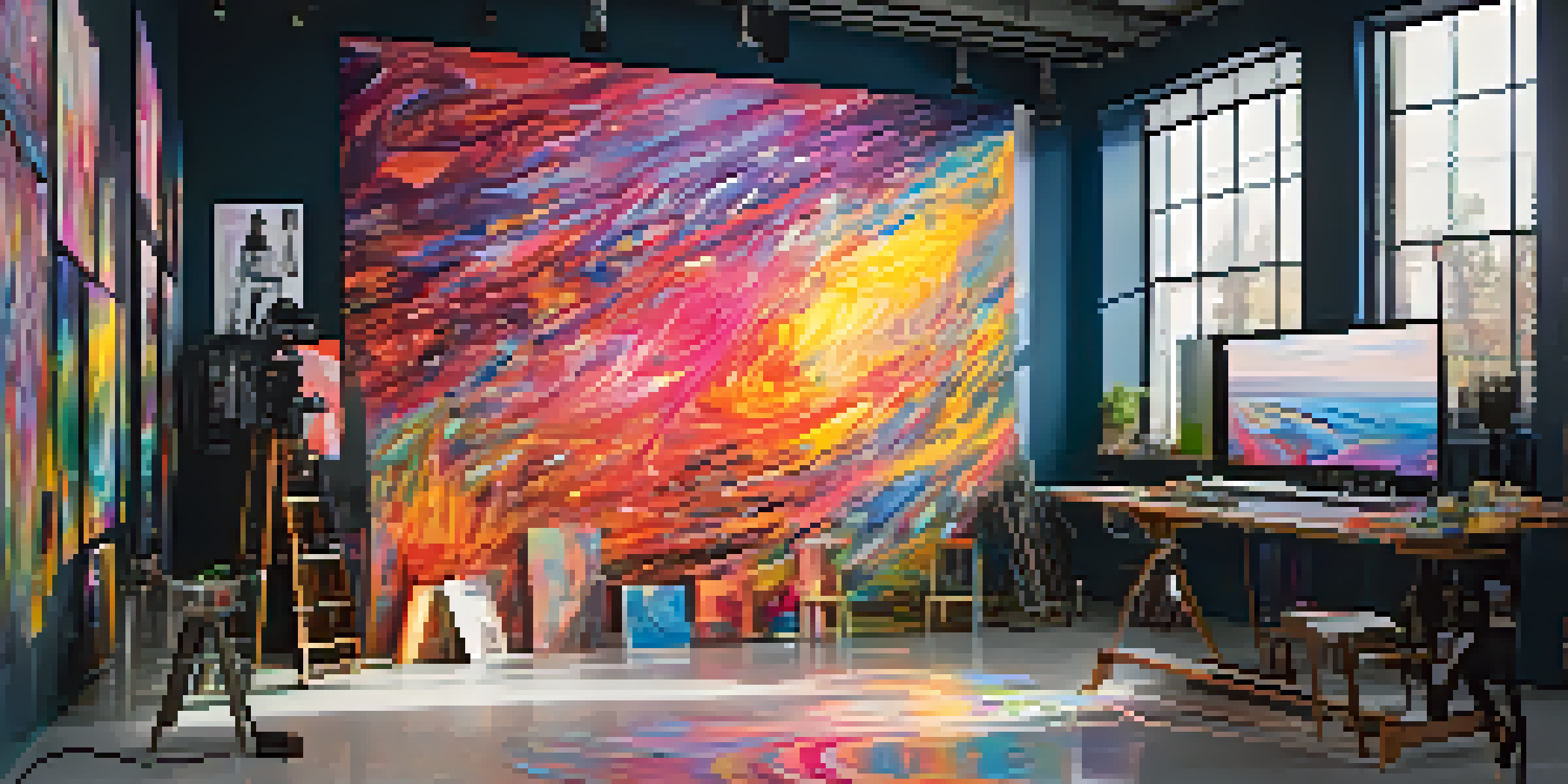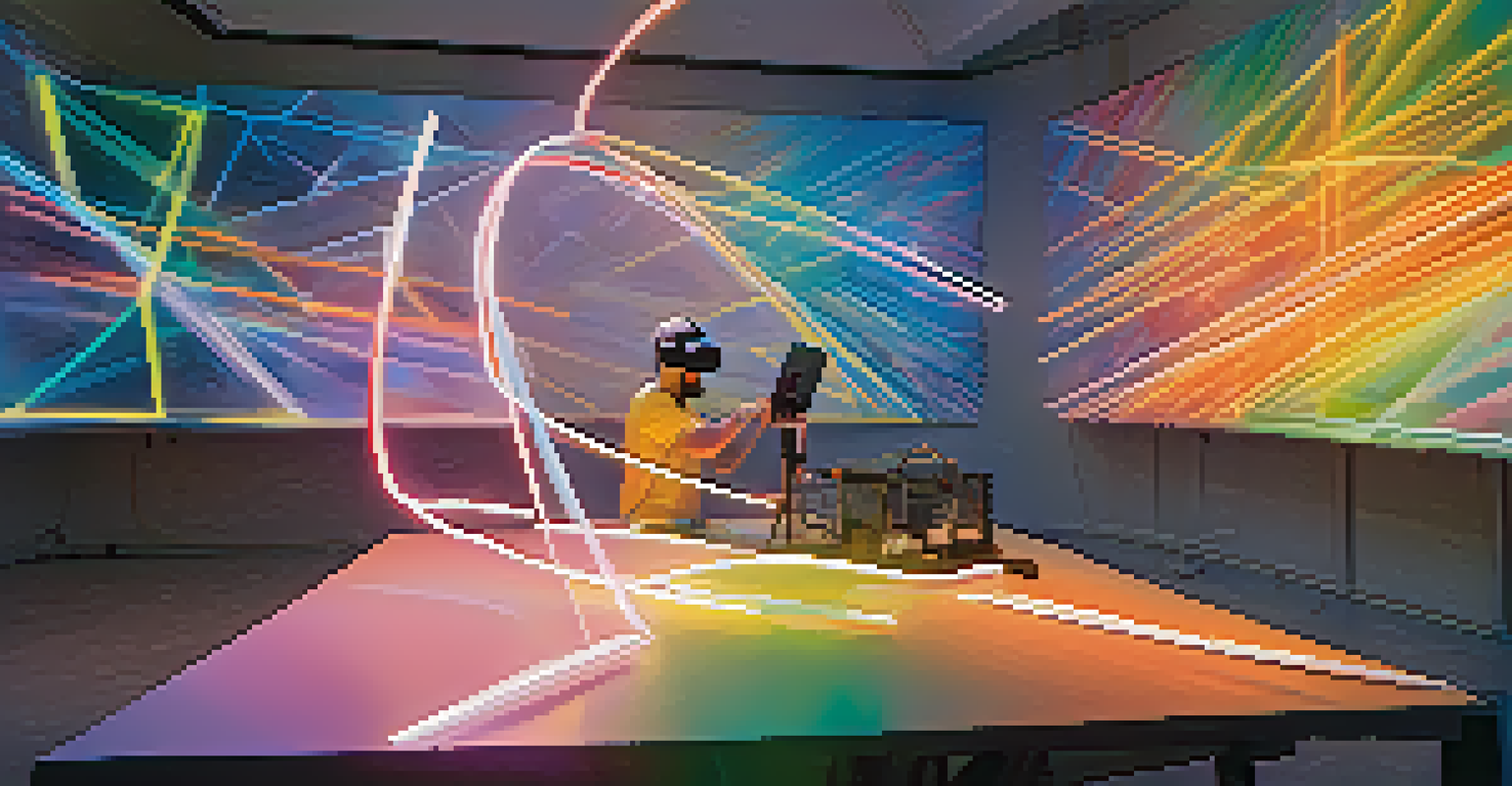The Role of Virtual Reality in Modern Painting Techniques

Understanding Virtual Reality in Art
Virtual reality (VR) is an immersive technology that creates a simulated environment, allowing users to interact with 3D spaces. In the realm of art, it offers painters an innovative canvas where traditional techniques meet modern technology. Artists can now visualize their work in a virtual space before committing to a physical medium, enhancing their creative process.
Art is not a thing; it is a way.
This technology goes beyond mere visualization; it enables artists to explore concepts that might be difficult to achieve on a flat surface. Imagine ‘painting’ in a 360-degree environment, where each brushstroke is projected around you. This not only expands the creative possibilities but also transforms how artists think about space and perspective.
Moreover, VR invites collaboration in real-time, connecting artists across the globe. They can create and share their works simultaneously, breaking geographical barriers and fostering a sense of community. This collaborative spirit enhances the artistic experience, pushing the boundaries of what can be achieved in modern painting.
New Techniques Enabled by VR
With VR, artists can employ techniques that simply weren’t possible before. For instance, they can paint in three-dimensional space, adding depth and dimension to their work. This technique allows for a more dynamic interaction with the artwork, as viewers can experience it from different angles, much like walking around a sculpture.

Additionally, VR tools often include features that simulate various materials and textures. Artists can experiment with brush types, colors, and techniques digitally, making it easier to refine their ideas before applying them to traditional canvases. This experimentation can lead to innovative styles that blend digital and physical art forms.
VR Transforms Artistic Creation
Virtual reality enables artists to explore new dimensions and techniques, enhancing their creative processes and expanding artistic possibilities.
Furthermore, the ability to undo or alter strokes in VR encourages risk-taking. Artists can push their limits without the fear of ruining a canvas, fostering a more playful and exploratory approach to painting. This freedom can inspire new creative pathways and lead to unexpected artistic breakthroughs.
The Learning Curve: VR for Aspiring Artists
For aspiring artists, VR can serve as an educational tool that enhances learning. Many VR platforms offer tutorials and guided experiences that teach painting techniques in an engaging manner. This immersive learning environment caters to various learning styles, making art more accessible to everyone, regardless of their background.
Creativity takes courage.
Additionally, VR allows students to practice in a risk-free environment. They can try different techniques without the pressure of a traditional classroom. This flexibility encourages experimentation and can help build confidence in their artistic abilities, ultimately leading to a more profound understanding of painting.
Moreover, many art schools are incorporating VR into their curriculums, recognizing its potential to revolutionize art education. By blending traditional methods with technology, students can gain a comprehensive skill set that prepares them for modern art careers, where digital literacy is increasingly important.
Connecting Artists and Audiences Virtually
One of the most exciting aspects of VR in painting is its ability to connect artists with audiences in new ways. Virtual exhibitions allow people from all over the world to experience art without the constraints of location. This accessibility can significantly broaden an artist's reach and enhance their visibility in the art community.
In a virtual gallery, viewers can engage with the artwork in ways that traditional exhibitions may not offer. They can walk through the space, examine details up close, and even interact with the art. This level of engagement creates a deeper appreciation for the work and fosters a more personal connection between the artist and the audience.
New Learning Opportunities with VR
Aspiring artists can benefit from immersive learning experiences in virtual reality, allowing for risk-free experimentation and skill development.
Furthermore, VR platforms can host live events, where artists can showcase their process in real-time. This transparency not only demystifies the creative process but also allows audiences to engage with artists directly, asking questions and providing feedback. Such interactions can build a loyal following and create a vibrant art community.
Challenges of Integrating VR in Painting
While the promise of VR in painting is exciting, there are challenges to consider. The technology can be costly, and not all artists have access to the necessary equipment. This disparity can create a divide in the art community, where only those with resources can fully embrace these modern techniques.
Additionally, there’s a learning curve associated with VR software that can be intimidating for some artists. Those accustomed to traditional methods may find it difficult to adapt to a virtual environment. However, as technology evolves, user-friendly interfaces are being developed, making VR more accessible to artists of all skill levels.
Lastly, there’s an ongoing debate about the authenticity of digital art. Some traditionalists argue that art created in a virtual space lacks the tactile quality of physical painting. However, as VR continues to evolve and gain acceptance, it’s becoming clear that these new methods can coexist with traditional practices, enriching the art world rather than detracting from it.
The Future of Painting: A Blend of Realities
As we look to the future, it’s evident that virtual reality will play a significant role in the evolution of painting. The fusion of digital and traditional mediums is creating a new genre of art that challenges conventional definitions. Artists are finding innovative ways to combine techniques, leading to a rich tapestry of styles and expressions.
Moreover, as technology continues to advance, the tools available to artists will become even more sophisticated. We can anticipate developments such as haptic feedback devices that allow artists to feel their brushstrokes in a virtual setting, enhancing the experience further. This blending of the physical and digital worlds will continue to inspire new artistic movements.
Connecting Artists and Audiences
VR facilitates unique connections between artists and audiences, providing interactive experiences that deepen appreciation for art.
In essence, the future of painting is not about choosing between traditional and virtual techniques but rather embracing both. As artists navigate this exciting landscape, they will likely discover new ways to express their creativity, ultimately enriching the art world and inviting audiences to experience art in previously unimaginable ways.
Conclusion: Embracing New Horizons in Art
The integration of virtual reality into modern painting techniques represents a significant shift in how we approach art creation and appreciation. By merging traditional practices with cutting-edge technology, artists are expanding their creative horizons and redefining what it means to be an artist in the 21st century. This evolution not only enhances the artistic process but also democratizes art, making it more accessible to a global audience.
As we continue to explore the potential of VR, it’s essential for artists and audiences alike to remain open to new experiences. Embracing these changes can lead to a more vibrant and inclusive art community where innovation thrives. Ultimately, the role of virtual reality in painting could pave the way for future generations of artists to experiment and express themselves in ways we can only begin to imagine.

In conclusion, the marriage of virtual reality and modern painting techniques invites us to rethink our perceptions of art. It encourages collaboration, experimentation, and connection, making the artistic journey more exciting than ever. As we navigate this new landscape, one thing is clear: the future of painting is bright, filled with endless possibilities waiting to be explored.